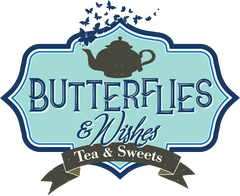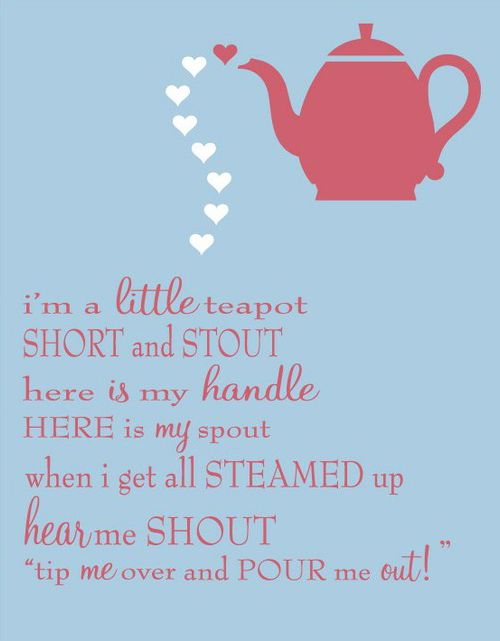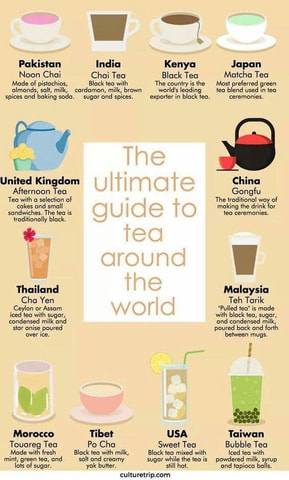CAMMELLIA SINENSIS
Of the more than 3,000 varieties of tea (not including herb teas)
all begin with the dried leaves of one plant: "Camellia Sinensis"
This species of Camellia grow throughout Asia, and develops slightly different tastes depending upon the soil, climate and elevation. When harvested, dried, and processed, these leaves become what is collectively known a black tea.
Tea names often indicate geographic origin:
*information provided by Country Tea Parties - Maggie Stuckey
Of the more than 3,000 varieties of tea (not including herb teas)
all begin with the dried leaves of one plant: "Camellia Sinensis"
This species of Camellia grow throughout Asia, and develops slightly different tastes depending upon the soil, climate and elevation. When harvested, dried, and processed, these leaves become what is collectively known a black tea.
Tea names often indicate geographic origin:
- Assam is a providence in northern India
- Ceylon tea comes from Sri Lanka
- Darjeeling is a district in the foothills of Himalyas
*information provided by Country Tea Parties - Maggie Stuckey
TEA BLENDS
Most packaged tea is a blend of two or more varieties:
English Breakfast and Irish Breakfast, for instance, as well as just plain tea in teabags.
Scented teas are flavored with essential oils of flowers, fruits and spices.
The most popular is Earl Grey, which contains orange oil.
Orange pekoe, is not a variety or a blend but a term that designates size of the tea leaf.
*information provided by Country Tea Parties - Maggie Stuckey
Most packaged tea is a blend of two or more varieties:
English Breakfast and Irish Breakfast, for instance, as well as just plain tea in teabags.
Scented teas are flavored with essential oils of flowers, fruits and spices.
The most popular is Earl Grey, which contains orange oil.
Orange pekoe, is not a variety or a blend but a term that designates size of the tea leaf.
*information provided by Country Tea Parties - Maggie Stuckey
Hot Tea - The Basics
To brew a pot of tea any size with loose leaf tea:
and this affects the taste of the tea.
*information provided by Tea with a Twist - Lisa Boalt Richardson, Certified Tea Specialist
To brew a pot of tea any size with loose leaf tea:
- Use spring water or fresh, cold water from the tap.
and this affects the taste of the tea.
- Warm the teapot with very hot water from the tap, discard the water.
- Heat the water until it reaches the correct temperature, generally 160-180 degrees for green and white tea, 190-200 degrees for oolong and a full boil for black teas, herbal infusions and fruit blends. Pour the water over the leaves immediately and cover your teapot or mug.
- Steep the tea for the time instructed on the tea package, generally 1-3 minutes for
- After steeping remove the leaves.
*information provided by Tea with a Twist - Lisa Boalt Richardson, Certified Tea Specialist
Tea Bag Faux Pas
Picking up the tea bag by the tab on the string and jiggling it up and down
to speed up the steeping process. This doesn't speed up the process.
Removing the tea bag from the teapot and placing it on the saucer.
This looks messy and you will have a puddle of tea in your saucer
which will produce dripping when you lift it.
Draining a tea bag by winding the string around the spoon.
This act will place one firmly in the Tea Drinkers' Hall of Shame.
*information provided by The Protocol School of Washington DC
Tea & Etiquette
Taking Tea for Business and Pleasure
Dorthea Johnson
Picking up the tea bag by the tab on the string and jiggling it up and down
to speed up the steeping process. This doesn't speed up the process.
Removing the tea bag from the teapot and placing it on the saucer.
This looks messy and you will have a puddle of tea in your saucer
which will produce dripping when you lift it.
Draining a tea bag by winding the string around the spoon.
This act will place one firmly in the Tea Drinkers' Hall of Shame.
*information provided by The Protocol School of Washington DC
Tea & Etiquette
Taking Tea for Business and Pleasure
Dorthea Johnson
United States Grown Tea
South Carolina and Hawaii are the only locations in the United States
where tea estates grow, process and market a black tea.
*information provided by The Protocol School of Washington DC
Tea & Etiquette
Taking Tea for Business and Pleasure
Dorthea Johnson
South Carolina and Hawaii are the only locations in the United States
where tea estates grow, process and market a black tea.
*information provided by The Protocol School of Washington DC
Tea & Etiquette
Taking Tea for Business and Pleasure
Dorthea Johnson
Black Tea
Black tea undergoes the longest process of oxidation.
Black teas are made from leaves that are allowed to ferment or oxidize,
then are fired or heated to remove most of the moisture.
The heat is what turns the leaves black.
Black teas produce a hearty brew that is higher in caffeine content than other teas
(but still lower than coffee).
Black tea undergoes the longest process of oxidation.
Black teas are made from leaves that are allowed to ferment or oxidize,
then are fired or heated to remove most of the moisture.
The heat is what turns the leaves black.
Black teas produce a hearty brew that is higher in caffeine content than other teas
(but still lower than coffee).
Shelf Life for Tea
When you keep tea away from light and moisture,
the loose tea can have a shelf life of about two years.
Bagged tea can have a shelf life of six months.
When you keep tea away from light and moisture,
the loose tea can have a shelf life of about two years.
Bagged tea can have a shelf life of six months.
Lemon Juice and Milk
Milk in tea? Yes.
A slice of lemon? Most certainly.
BUT NEVER MIX THE TWO IN THE SAME CUP.
The acid in the lemon juice will curdle the milk and
leave it looking and tasting most peculiar.
Milk in tea? Yes.
A slice of lemon? Most certainly.
BUT NEVER MIX THE TWO IN THE SAME CUP.
The acid in the lemon juice will curdle the milk and
leave it looking and tasting most peculiar.
Flavor Your Food
Flavor your food.
Tea can be steeped in nearly any liquid to add a unique flavor to your dishes.
Steep tea in broth for soup, poach meats and fish in tea, and add tea to milk, coconut milk, and/or juice to provide a tasty base for desserts.
You can even hang a couple tea bags over the side of the pot as you boil pasta
or prepare water for cooking rice and other grains.
Flavor your food.
Tea can be steeped in nearly any liquid to add a unique flavor to your dishes.
Steep tea in broth for soup, poach meats and fish in tea, and add tea to milk, coconut milk, and/or juice to provide a tasty base for desserts.
You can even hang a couple tea bags over the side of the pot as you boil pasta
or prepare water for cooking rice and other grains.
RELIEVE TIRED EYES
Relieve tired, puffy eyes by placing a chilled, used tea bag on them for 15 minutes.
It will reduce puffiness and even under eye circles.
Relieve tired, puffy eyes by placing a chilled, used tea bag on them for 15 minutes.
It will reduce puffiness and even under eye circles.
Thorough Cleaning of a Tea Pot
Every teapot needs a thorough cleaning occasionally.
To get rid of tannin stains, fill the the pot up with very hot water and drop in a fizzy denture-cleaning tablet. Make sure you tip the pot to get the solution up the spout.
Leave for at least one hour before rinsing.
Every teapot needs a thorough cleaning occasionally.
To get rid of tannin stains, fill the the pot up with very hot water and drop in a fizzy denture-cleaning tablet. Make sure you tip the pot to get the solution up the spout.
Leave for at least one hour before rinsing.
Tea as Fertilizer
Tea is a valuable fertilizer for your garden.
It contains useful quantities of nitrogen, potash and other nutrients for plants.
So always empty your tea pot onto the flower bed or the compost heap.
Tea is a valuable fertilizer for your garden.
It contains useful quantities of nitrogen, potash and other nutrients for plants.
So always empty your tea pot onto the flower bed or the compost heap.
Roast Chicken and Tea Leaves
Roast chicken can be given a gentle lift by tea leaves.
Put a sheet of foil on the bottom of the roasting tin,
sprinkle with tea leaves and sugar, and put the chicken on top.
Roast in the normal way until the chicken skins is brown and crispy.
Roast chicken can be given a gentle lift by tea leaves.
Put a sheet of foil on the bottom of the roasting tin,
sprinkle with tea leaves and sugar, and put the chicken on top.
Roast in the normal way until the chicken skins is brown and crispy.
Fridge Odors and Tea
Get rid of odors in your fridge.
Fill a cotton or muslin bag with green tea leaves
and leave it inside the refrigerator.
Get rid of odors in your fridge.
Fill a cotton or muslin bag with green tea leaves
and leave it inside the refrigerator.
Removing Tea Stains
Removing tea stains from upholstery by washing as soon as possible
with a biological detergent.
Dab stubborn stains on a white material
with a very weak (10 to 1) solution of hydrogen peroxide in water.
*The Little Book of Tea Tidbits - Andrew Langley
Removing tea stains from upholstery by washing as soon as possible
with a biological detergent.
Dab stubborn stains on a white material
with a very weak (10 to 1) solution of hydrogen peroxide in water.
*The Little Book of Tea Tidbits - Andrew Langley
DYE FABRICS
Tea can be used to dye natural fabrics.
Make a new tablecloth look vintage or give a stained curtain new life
with a sepia shade or hue from tea.
Tea can be used to dye natural fabrics.
Make a new tablecloth look vintage or give a stained curtain new life
with a sepia shade or hue from tea.
OVERBOILING WATER
Over boiling causes water to lose oxygen
and can make your tea taste flat.
Over boiling causes water to lose oxygen
and can make your tea taste flat.
Tea Superstition
Bubbles on tea denote kisses
Bubbles on tea denote kisses
Afternoon Tea History
Afternoon tea was started by Anna,
seventh Duchess of Bedford, in the nineteenth century.
She invited guests for tea and sweets in the afternoon
to help fill the long gap between breakfast and dinner.
Soon this become tradition in England and North America.
Afternoon tea was started by Anna,
seventh Duchess of Bedford, in the nineteenth century.
She invited guests for tea and sweets in the afternoon
to help fill the long gap between breakfast and dinner.
Soon this become tradition in England and North America.


